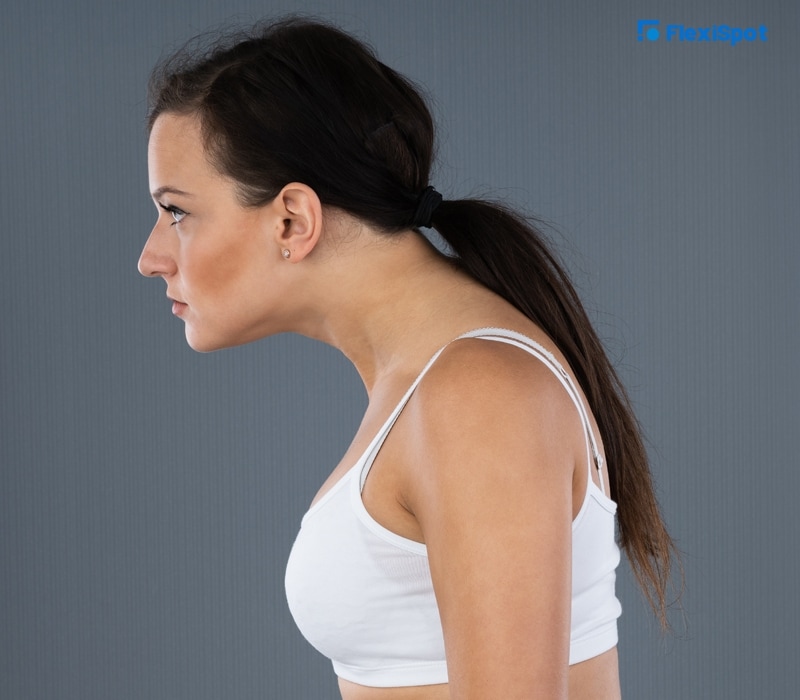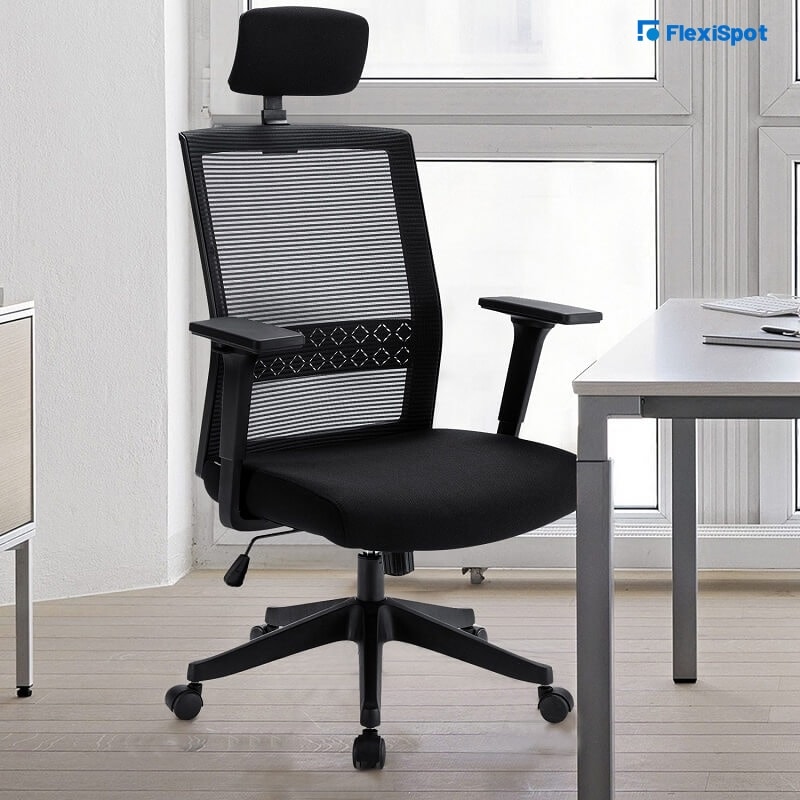Does your neck slant forward, and your head is not aligned with your shoulders? Do you think your head props out in front of your body? You might have a forward head posture. Also known as nerd neck, this posture can strain your neck muscles and add extra pressure on your spine. It leads to chronic fatigue, cervical pain, and other painful and uncomfortable symptoms that will affect your quality of life.
You can take several steps to improve your forward head posture, including performing neck and head exercises, resting your head on a cervical pillow, investing in an ergonomic office mesh chair, and more
Let’s see what forward head posture is and what you can do to improve it!
How to Assess Your Posture
Stand with your back against the wall. Your heels and shoulder blades should touch the wall and your feet should be shoulder-width apart. Keep a neutral back position. Squeeze your shoulder blades together and release them a few times to achieve this posture. If the back of your skull is touching the wall, you don’t have a forward head posture. However, if there’s a gap between the wall and the back of your skull, you have some degree of forward head posture.

Causes of a Forward Head Posture
Forward head posture is usually caused by:
Spending too much time looking down on your phone
Excessively using the computer
Driving long hours every day
Sleeping with your head elevated, i.e., using several pillows or propping your head against a sofa’s armrest
Carrying a weighty backpack
Other causes of having a forward head posture include weak neck muscles, past neck injuries, improper breathing, practicing sports that favor one side of the body, such as tennis, badminton, golf, etc., and having a profession that involves repetitive movements, such as writer, computer programmer, hairstylist, painter, etc.
Forward Head Posture Side Effects
Forward head posture causes upper back muscle tightness and weakness in the muscles at the front of the neck. This imbalance leads to multiple musculoskeletal, neural, and cardiovascular side effects. The nerves, joints, and muscles in the neck and back face undue pressure, resulting in shoulder, upper back, and neck pain. The rounded shoulders also put an extra burden on the lower back that can lead to herniated discs.
These side effects cause tension neck syndrome, which you cannot distinguish from a tension headache. Your altered center of balance makes you more susceptible to injuries. Moreover, some other side effects of forward head posture include muscle spasms, kyphosis, chronic fatigue, restricted breathing, sleep apnea, insomnia, and numbness of the hands and arms. Over time, this posture can cause bulging discs, osteoporosis, reduced shoulder mobility, and cervical spine arthritis.

How to Improve Forward Head Posture
You can correct your forward head posture by following these steps:
Start Your Mornings with Chin Tucks & Chest Stretches
A chin tuck is an easy exercise that strengthens your upper thoracic extensors, i.e., the muscles that align your head over your shoulders. To perform a chin tuck, stand with your upper back touching a wall and keep your feet as far apart as the width of your shoulders. Keep your face frontward, fold your chin, and pull your head back until it touches the wall. Hold the position for five seconds before resting. Repeat this exercise 10 times.
Then, perform chest stretches to ensure your shoulders and head have an easier time maintaining a healthy posture. It will keep your chest muscles from feeling tight. Stand in your doorway. Put your forearms against each door jamb and put your elbows slightly below shoulder level. Lean forward into the doorway until you feel your chest stretching under your collarbone. Hold the position for up to a minute. You can start by holding it for ten seconds and build up to a minute.
Perform an Upper Trapezius Stretch
This exercise will stretch out your neck and upper back muscles which can get very tense if you have forward neck syndrome. Start by standing or sitting in a chair. Put one of your hands on the opposite side of your head. Then, slowly bring your head down toward your shoulder. Use the overhead hand to press your neck down to get a deeper stretch. Make sure you don’t overdo it, though. Hold the position for 10-20 seconds.
Squeeze Your Shoulder Blades
Squeezing your shoulder blades will activate and strengthen your mid and lower back muscles, including your mid and low trapezius. Keep your feet and knees slightly wider than your hips and sit on a chair. Hold a chin tuck and raise your chest up, ensuring your spine is in a neutral position. Rest your arms down by your sides, bring them back and rotate them externally so that your thumbs are pointing back. Hold this position for 10 seconds. Repeat at least 10 to 15 times.

Invest in an Ergonomic Office Mesh Chair
If you work in a field that requires you to sit at a desk or look down on your computer all day, it’s easy to develop a forward head posture. However, you can counter that by investing in an ergonomic office mesh chair. It will help you align your head over your shoulders and give you a comfortable headrest. Here are some reasons why mesh is good for office chairs:
It offers more support than padded chairs
It improved posture
Mesh can reduce aches and pains related to musculoskeletal disorders
But what is the difference between an ergonomic chair and an office chair? An ergonomic chair is designed to offer your body the support it needs to keep muscle aches and strains at bay. It has a supportive and firm structure, and it offers several adjustments, allowing you to find the ideal sitting position and change your position throughout the day.

Create an Ergonomic Workstation
You will also need to create an ergonomic workstation for yourself to improve your forward head posture. Raise your computer monitor to your eye level. Your eyes should ideally hit the top third of the screen when you look straight ahead. Also, make sure the screen is 18 to 24 inches away from your head, i.e., it needs to be an arm’s length away.
Moreover, position your keyboard and mouse so that when you have to use them, your forearms are parallel to the floor and your elbows are bent at 90 degrees. You can also invest in a standing desk to ensure you change your posture throughout the day.
Use a Cervical Pillow
You will need to invest in a sleeping pillow that supports the natural curve of your neck. Look up cervical pillows online. Also known as orthopedic pillows, these pillows have a distinctive shape with curved centers that support the curves of your cervical spine and head.
The goal of these inward-curved cervical pillows is to keep your neck in a neutral position rather than arched forward. You can achieve this outcome by sleeping on your back and keeping a rolled-up towel under your neck. If your pillow is too high to too low, it can cause your head to lie in an unnatural position all night. It will result in muscle imbalance, which is hard to correct.
So, invest in a top-quality pillow that offers your body the support it needs. However, make sure that you don’t go with the popular choice. Instead, choose the pillow that works for your specific body and try different variations to find the one you are most comfortable using.
Select a Better Backpack
If you’re a student who needs to carry a heavy backpack every day, make sure to choose one that is proportional to your body. For instance, if you don’t have a bulky or tall body, don’t choose a huge backpack. Additionally, make sure your backpack is not needlessly heavy. Take out the time to remove the items you don’t regularly need so that you do not carry unnecessary weight.
As for the bulkier items that you need to carry regularly, make sure to position them near the center of the backpack to reduce excessive stress on your shoulders. Moreover, do not carry your backpack on one shoulder. Always use both the straps to even out the weight.
The Bottom Line
Forward head posture might not seem like a big deal. However, depending on its severity, it can affect your quality of life. The good news is that you can correct your posture and give your body the relief it needs by following the tips mentioned above.
However, you need to remember that forward head posture will not get corrected overnight. You will need to make these lifestyle changes and perform neck, head, and shoulder exercises regularly to correct your posture.
Moreover, you can reach out to FlexiSpot to invest in a premium-quality ergonomic office mesh chair that will help you keep a healthy posture. If you need ergonomic furniture designed for your comfort, explore our collection today!